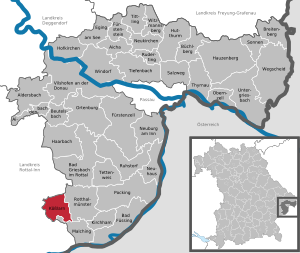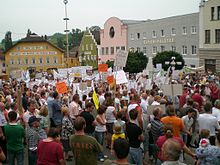Koesslarn
| coat of arms | Germany map | |
|---|---|---|

|
Coordinates: 48 ° 22 ' N , 13 ° 8' E |
|
| Basic data | ||
| State : | Bavaria | |
| Administrative region : | Lower Bavaria | |
| County : | Passau | |
| Height : | 425 m above sea level NHN | |
| Area : | 25.49 km 2 | |
| Residents: | 1954 (Dec. 31, 2019) | |
| Population density : | 77 inhabitants per km 2 | |
| Postal code : | 94149 | |
| Area code : | 08536 | |
| License plate : | PA | |
| Community key : | 09 2 75 131 | |
| Market structure: | 51 districts | |
Market administration address : |
Marktplatz 25 94149 Kößlarn |
|
| Website : | ||
| Mayor : | Willibald Lindner ( ödp / active citizens ) | |
| Location of the market in Kößlarn in the Passau district | ||
Kößlarn is a market in the Lower Bavarian district of Passau .
geography
Community structure
The municipality of Kößlarn has 51 districts:
Markings
There are the districts Hubreith, Kößlarn and Thanham.
history
The market belonged to the Landshut Rent Office and the Griesbach Regional Court of the Electorate of Bavaria. Kößlarn had a market court with its own magistrate rights.
Settlement beginnings
The Kößlarner seal from 1488 shows the name form kosl-orn . The ending -orn, often also -arun or -arn, indicates a settlement by a manor between 1000 and 1200 at the latest. Presumably the settlement was promoted by the Counts of Formbach , who owned the Grafenwald at that time. The word ending makes it clear that the settlement should fulfill a special mission. The syllable kosl- etymologically allows two assumptions: Either boilermakers were employed in the settlement or the first settlement was founded for pig farming. The former assumption is supported by the fact that all the raw materials needed for a forge were available in sufficient quantities. Water and wood were abundantly available, and ore deposits are still present today as evidence of the earthworks and pits.
Beginning of the pilgrimage
In 1364 the Count of Ortenburg rode by near the Kößlhof and wanted to cross the stream. When the horses shied away, the count and his servants turned around and found a carved image of Mary with the baby Jesus in a juniper bush. The pious count had a wooden hut built for the picture and was able to continue his way across the stream unhindered. In the same year the image of the Virgin performed its first miracle: the terminally ill Kößlbauer let himself be carried to the image of the Virgin and prayed. His faith and trust in God were rewarded and he was able to go home on his own. The story of this miraculous healing spread quickly and many sick and suffering people sought help from the Mother of God at the Kößlhof. Due to the many offerings and donations of the pilgrims, a small stone church with 3 altars was built in 1400, which was consecrated in 1443. A document from 1448 already lists 137 parishes which made pilgrimages to Kößlarn with crosses and flags. Up until the Reformation, Kößlarn was the most visited Marian pilgrimage site in "Unterland" Bavaria. In 1451 the second church was built. Memorial plaques and wall paintings in the church still indicate the beginnings of the pilgrimage in Kößlarn.
The heyday of pilgrimage
Originally, Kößlarn, which had "inherited" its name from Kößlhof, still belonged to the parish of Münster . However, since the chaplain from Münster was overwhelmed with the pilgrimage masses and the pilgrimage pastoral care, a position was created for a second chaplain in Kößlarn, who was given the task of reading mass every day. During this time, the "Hof im Kößl in front of the green forest" quickly became a small village with all the necessary trades and handicrafts to supply and support the numerous pilgrims. On January 9, 1474, Kößlarn received permission from Duke Ludwig the Rich to “openly pour wine and beer to pilgrims” and to set up restaurants. The village of Kößlarn became the ducal market. In order to ensure pastoral care for the pilgrims, the parish of Münster with the parts Kühnham and Kößlarn was transferred to the Cistercian monastery of Aldersbach by Pope Sixtus IV . In 1478 the market received its own parish vicar as well as its own chaplain and a pilgrimage preacher and thus achieved at least partial independence in pastoral care. During the heyday of the pilgrimage, six priests were active in Kößlarn. During the years 1461–1480 the churchyard fortifications were also built. The production of the showpiece of the Kößlarner Church in 1487 can also be interpreted as a further indication of the flourishing pilgrimage: Goldsmith Balthasar Waltenberger made the Silver Madonna, which is now exhibited in the church's votive room, using the market's own resources.
Incorporations
On April 1, 1971, the previously independent communities Hubreith and Thanham were incorporated.
Population development
In the period from 1988 to 2018, the market grew from 1,700 to 1,922 by 222 inhabitants or 13.1%.
| year | 1840 | 1900 | 1939 | 1950 | 1961 | 1970 | 1987 | 1991 | 1995 | 2005 | 2010 | 2015 |
| Residents | 1563 | 1725 | 1579 | 2549 | 1805 | 1790 | 1696 | 1774 | 2019 | 1951 | 1930 | 1891 |
politics
Market council
In the local elections on March 15, 2020, 996 of the 1,668 residents entitled to vote in Markt Kößlarn exercised their right to vote, bringing the turnout to 59.71%.
mayor
- –2002: Benno Hennhöfer (CSU / Free Voting Community)
- 2002–2014: Franz Holub (ödp / active citizens)
- 2014– : Willi Lindner (CSU / For Kößlarn / ÖDP / ABK / Youth for Kößlarn)
In the local elections on March 15, 2020, Willi Lindner, who has been in office since May 1, 2014, was re-elected with 97.82% of the votes.
Finances
In 2012 the municipal tax revenue amounted to € 857 thousand, of which € 171 thousand was trade tax income (net).
Architectural monuments
- The parish church "Heiligste Dreifaltigkeit" in Kößlarn is a late medieval fortified church and pilgrimage church .
- Ensemble Marktplatz (Kößlarn)
Soil monuments
See: List of soil monuments in Kößlarn
Economy and Infrastructure
tourism
The community is located in the middle of the so-called spa triangle ( Bad Griesbach , Bad Birnbach , Bad Füssing ). It generates its income mainly from tourism.
Attractions are, for example, the landscape and ancient customs such as the Palm Sunday procession, the harvest festival or the local farmers' market. The pilgrimage church is the only completely preserved fortified church in southern Germany. Since 2008, the Kößlarn church museum with exhibits on the history of pilgrimage and local customs has been on view in the fortification. Kößlarn is also on the European pilgrimage route Via Nova .
Jobs
In 2017 there were 293 jobs subject to social security contributions in the municipality. Of the resident population, 800 people were in employment subject to compulsory insurance. This means that the number of out-commuters was 507 more than that of in-commuters. 47 residents were unemployed.
Agriculture
In 2016 there were 39 farms; 1037 hectares of the community area were used for agriculture.
education
In 2018 there were the following institutions:
- Kindergarten St. Josef with 71 places, in which 48 children are cared for and supported by twelve people
- Elementary school Kößlarn, where 65 students in four classes are taught by six teachers (school year 2017/18)
- Church museum
Personalities
- Johann Baptist Modler (1697–1774), Rococo sculptor and plasterer
literature
- Josef Huber: Parish and pilgrimage church Kößlarn. 4th revised edition. Schnell & Steiner publishing house, 1992.
- Josef Hofbauer: Markt Kößlarn 1483. Neue Presse Verlag, Passau 1985.
Individual evidence
- ↑ "Data 2" sheet, Statistical Report A1200C 202041 Population of the municipalities, districts and administrative districts 1st quarter 2020 (population based on the 2011 census) ( help ).
- ↑ Kößlarn, M. on: bayerische-landesbibliothek-online.de
- ^ Wilhelm Volkert (ed.): Handbook of Bavarian offices, communities and courts 1799–1980 . CH Beck, Munich 1983, ISBN 3-406-09669-7 , p. 474 .
- ↑ City council election 2020
- ↑ City council election 2020
- ↑ Mayoral election 2020
Web links
- Entry on the coat of arms of Kößlarn in the database of the House of Bavarian History







